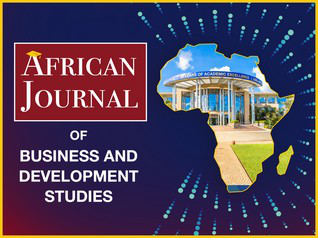Working from Home, Employee Trust and Organizational Performance at Safaricom Plc in Kenya
DOI:
https://doi.org/10.70641/ajbds.v1i2.136Keywords:
Working from Home, Organizational Performance, TrustAbstract
The specific objective of the research was to establish whether Working from Home has affected trust between employees and organization performance at Safaricom PLC in Kenya. The study adopted the explanatory research design to get primary data from the respondents that were working in the Human Resource Department on the effects of working from home on organizational performance. The target population was 99 respondents. The sample size conveniently targeted all the Ninety-nine employees who were working in the HR department at the time. Data collection was done through online questionnaire and analysis was done through used to test the effect of the variables at 95% confidence level. The findings revealed a positive effect between trust and organizational performance at (β=0.616, P=0.00). The study concluded that trust was a significant determinant variable of the organizational performance at Safaricom PLC in relation to employees working from home. Based on this conclusion, the study recommended that employers would need to provide data, logistical support, and training for workers to effectively use teleworking to enhance working conditions and workers’ productivity. One approach that may help employees go through the challenges associated with working from home is mindfulness. Employers also need to provide data and logistical support and training for workers to effectively use virtual/ teleworking to enhance working conditions and eventually workers’ productivity.
References
Anakpo, G., Nqwayibana, Z., & Mishi, S. (2023). The impact of work-from-home on employee performance and productivity: a systematic review. Sustainability, 15(5), 4529. DOI: https://doi.org/10.3390/su15054529
Bailyn, L. (1989). Toward the perfect workplace'', Communications of the ACM,32 (4), 460-71. DOI: https://doi.org/10.1145/63334.63338
Baldry, C. (1999). ‘Space: the final frontier’. Sociology, 33: 535–53 DOI: https://doi.org/10.1017/S0038038599000346
Baldry, C. (1999). Space, technology, and work: Theories and practices of workplace change. Work, Employment & Society, 13(3), 531–552.
Baldry, C., Bain, P., & Taylor, P. (1998). Bright satanic offices: Intensification, control and team Taylorism. Capital & Class, 22(2), 1–24. DOI: https://doi.org/10.5040/9781350391437.ch-009
Bryman, A. and Bell, E. (2011). Business Research Methods. Oxford: Oxford University.
Charalampous, M., Grant, C. A., Tramontano, C., & Michailidis, E. (2019). Systematically reviewing remote e-workers’ well-being at work: A multidimensional approach. European Journal of Work and Organizational Psychology, 28(1), 51–73. https://doi.org/10.1080/1359432X.2018.1541886 DOI: https://doi.org/10.1080/1359432X.2018.1541886
Choukir, J. H., Alqahtani, A. F., Khalil, A. M., & Mohammed, M. A. (2022). The effects of working from home on job performance: Empirical evidence in the Saudi context during the COVID-19 pandemic. Journal of Public Affairs, 22(3), e2716. https://doi.org/10.1002/pa.2716
Choukir, J., Alqahtani, S., Khalil, E., & Mohamed, E. (2022), “Effects of working from home on Job Performance: Empirical evidence in the Saudi context during the COVID-19 Pandemic”. International Research Journal, 2(1), 65-78. DOI: https://doi.org/10.3390/su14063216
Deci, E. L., & Ryan, R. M. (1985). Intrinsic motivation and self-determination in human behavior. Springer Science & Business Media. DOI: https://doi.org/10.1007/978-1-4899-2271-7
Dwelly, T. (2000). Living at Work: A New Policy Framework for Modern Home Workers. York: Joseph Rowntree Foundation.
Dwelly, T. (2000). Teleworking: The myth of flexibility. The Work Foundation.
Eleonora, G. (2020). Organizational Performance – Theoretical and practical approaches. University of Bucharest, Romania.
Felstead, A., Jewson, N. & Walters, S. (2003), Managerial Control of Employees Working from Home, British Journal of Industrial Relations41(2), 241-264. DOI: https://doi.org/10.1111/1467-8543.00271
Giacosa, E., Alam, G. M., Culasso, F., & Crocco, E. (2023). Stress-inducing or performance-enhancing? Safety measure or cause of mistrust? The paradox of digital surveillance in the workplace. Journal of Innovation & Knowledge, 8(2), 100357. DOI: https://doi.org/10.1016/j.jik.2023.100357
Grant, A., Wallace, P. Tramontano, C., & Charalampous. M. (2019.) “Construction and Initial Validation of the e-Work Life Scale to Measure Remote e-Working.” Employee Relations 41 (1): 16–33. DOI: https://doi.org/10.1108/ER-09-2017-0229
Huws, U., Korte, W. B., & Robinson, S. (2000). Telework: Towards the elusive office. John Wiley & Sons.
Huws, U., O'Regan, S., & Honey, S. (2000). An Evaluation of Homeworking in ACAS, ACAS Research Paper Series, no. 2
Kothari, R., & Garg, G. (2014). Research Methodology. Third Edition, New Age International Publishers, New Delhi.
Marcus, T. (1993). Buildings and Power: Freedom and Control in the Origins of Modern Building Types. London: Routledge
Mayer, R. C., Davis, J. H., & Schoorman, F. D. (1995). An integrative model of organizational trust. Academy of Management Review, 20(3), 709–734. DOI: https://doi.org/10.2307/258792
Microsoft Work Trend Index. (2022). Great expectations: Making hybrid work work. Microsoft. Retrieved from https://www.microsoft.com/en-us/worklab/work-trend-index
Nakrosiene, A., Buciuniene, & Gostautait e, B (2019). Working from home: Characteristics and outcomes of telework. ˙ International Journal of Manpower, 40, (2)87–101. DOI: https://doi.org/10.1108/IJM-07-2017-0172
Nakrosiene, A., Buciuniene, I., & Gostautaitė, B. (2019). Working from home: Characteristics
PwC. (2021). The future of remote work: Remote work survey. Retrieved from https://www.pwc.com/gx/en/issues/upskilling/global-remote-work-survey.html
Sander, L. (2020). The impact of remote work on organizational culture. Harvard Business Review Digital Articles. Retrieved from https://hbr.org
Sander, L., (2020). “Coronavirus could spark a revolution in working from home. Are we ready?”Journal of management 1(2), 115-135.
Taboroši, S., Strukan, E., Poštin, J., & Nikolić, M. (2020). Organizational commitment and trust at work by remote employees. Journal of Engineering Management and Competitiveness (JEMC), 10(1), 48-60. DOI: https://doi.org/10.5937/jemc2001048T
Taherdoost, H. (2016). Sampling Methods in Research Methodology. New York, NY: McGraw-Hill
Taylor, R. (2002). Managing Change in the Workplace, ESRC Future of Work Programme Seminar Series. London: Economic and Social Research Council.
Taylor, R. (2002). The management of teleworkers: Strategies for success. Personnel Review, 31(4), 438–452.
Thorstensson, E. (2020). The influence of working from home on employees' productivity: A comparative analysis of different sectors in Sweden. Journal of Business and Management Studies, 6(2), 45–61. https://doi.org/10.2139/ssrn.3627332
Wiedow, A., Konradt, U., Ellwart, T., & Steenfatt, C. (2018). Direct and indirect effects of team learning on team outcomes: A multiple mediator analysis. Group Dynamics: Theory, Research, and Practice, 17(4), 232. DOI: https://doi.org/10.1037/a0034149
Downloads
Published
How to Cite
Issue
Section
License
Copyright (c) 2025 Pauline Antonina Kageni & James Mark Ngari

This work is licensed under a Creative Commons Attribution-NonCommercial-ShareAlike 4.0 International License.





 This work is licensed under a
This work is licensed under a 